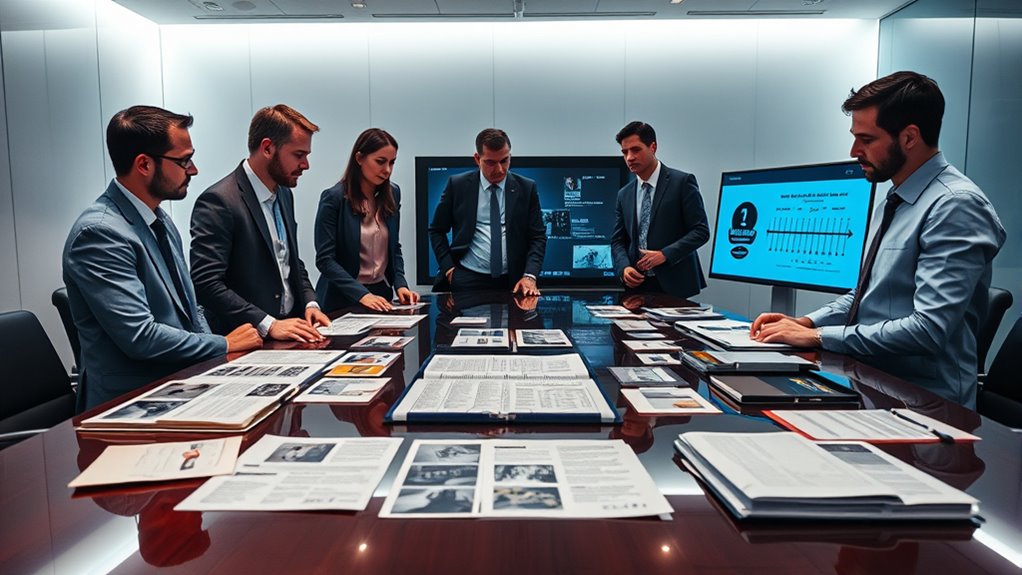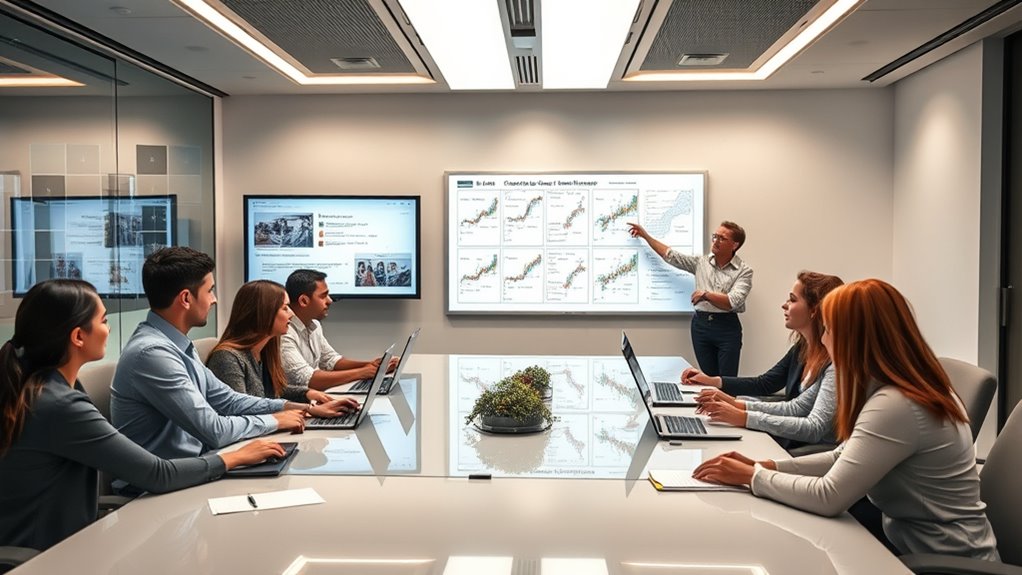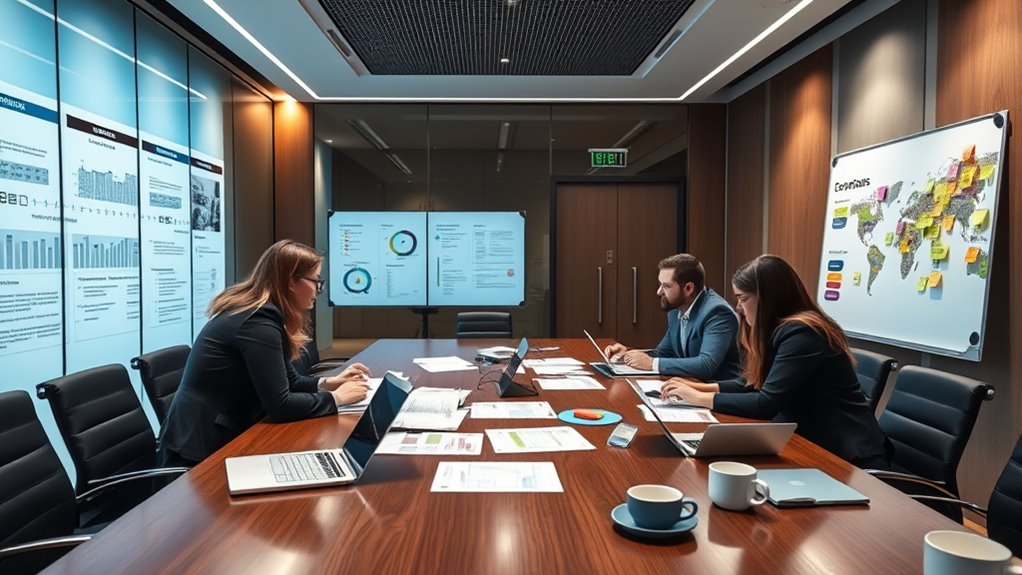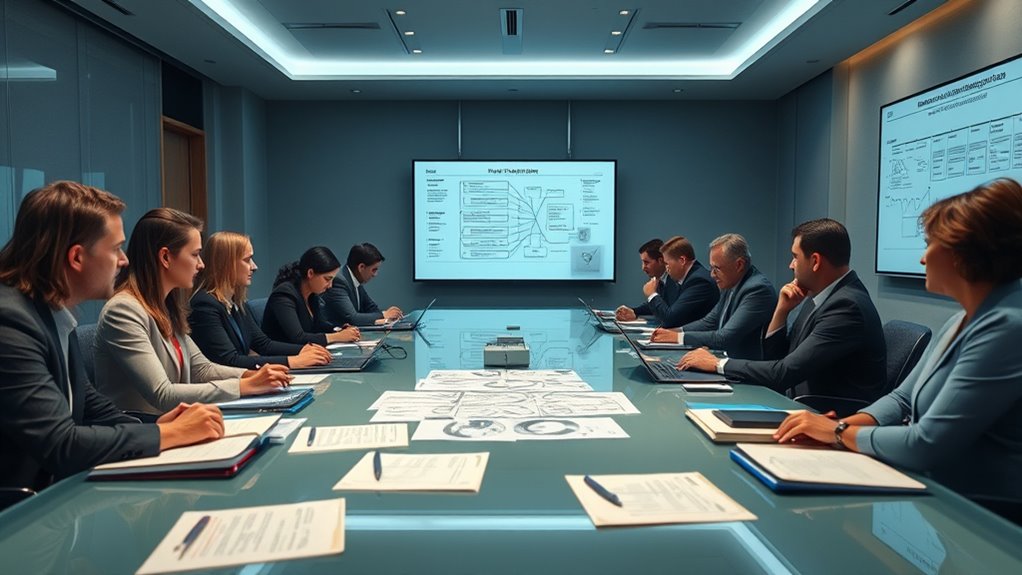After each case, your team conducts a structured debrief to review what worked well, gather feedback, and identify areas for improvement. You review case documentation and evidence to guarantee everything is thorough and properly stored. You analyze outcomes, strengths, and lessons learned to refine your approach. This process also includes evaluating protocols, making adjustments, and sharing insights to promote continuous learning. If you keep exploring, you’ll discover how to enhance your team’s effectiveness even further.
Key Takeaways
- The team gathers feedback to identify strengths, lessons learned, and areas for improvement after each case.
- Case documentation and evidence are thoroughly reviewed to ensure accuracy, proper handling, and identify discrepancies.
- Outcomes are analyzed against success metrics to evaluate resolution effectiveness and identify opportunities for process improvements.
- Communication and adherence to protocols are assessed to enhance collaboration and ensure procedural compliance.
- Insights from the debrief inform future resource allocation, planning, and continuous improvement strategies.
Gathering the Investigation Team’s Feedback

Gathering the investigation team’s feedback is a crucial step in understanding what went well and what could be improved. When you actively seek input from your team, you boost team morale by showing that their opinions matter. This process helps identify areas where resource allocation was effective and where adjustments are needed. You might discover that certain tools or personnel were underutilized, or that some team members faced challenges due to workload distribution. By listening to their experiences, you can make better decisions for future investigations, ensuring resources are allocated efficiently and morale remains high. Incorporating projector technology insights from the team can further enhance the overall process. Recognizing communication patterns during debriefs can reveal underlying issues affecting team collaboration. Being aware of grocery store hours can also inform resource planning and scheduling for investigations involving retail environments. Additionally, understanding team dynamics can contribute to more effective cooperation and problem-solving. Engaging your team in this way fosters a sense of ownership and continuous improvement, ultimately strengthening the overall investigation process. Moreover, considering appliance maintenance plans can help ensure that equipment used during investigations remains reliable and functional, reducing potential delays or issues.
Reviewing Case Documentation and Evidence

Reviewing case documentation and evidence is a vital step in guaranteeing the accuracy and completeness of your investigation. You need to carefully examine all case documentation, verifying that records are thorough, properly organized, and free of inconsistencies. Evidence management is essential; you should double-check the chain of custody, proper labeling, and storage of all evidence collected. This process helps prevent errors and guarantees nothing is overlooked. As you review, look for gaps or discrepancies that could impact your findings. Keep detailed notes on your observations and any additional evidence needed. Effective evidence management and meticulous review of documentation not only strengthen the integrity of your investigation but also prepare you for any future inquiries or legal proceedings. Additionally, staying informed about emerging AI vulnerabilities can help you anticipate and address potential security concerns related to digital evidence handling. Being aware of common symbols can also aid in recognizing patterns or clues that might be relevant during your review process. Incorporating knowledge of water-related safety can further enhance your understanding of environmental factors that may influence certain evidence, especially in cases involving water or aquatic environments. Recognizing proper documentation techniques ensures that all records are consistent and reliable throughout the investigation. Furthermore, understanding digital evidence handling protocols can help maintain the chain of custody and prevent tampering or contamination.
Analyzing Key Findings and Outcomes

Now, it’s time to evaluate how effective the case resolution was and identify what worked well or needs enhancement. Reviewing the evidence and data helps you understand the strengths and gaps in your investigation. These insights provide valuable lessons to improve future cases and ensure better outcomes. Incorporating proper application timing for pimple patches can enhance treatment effectiveness and support overall skincare goals. Additionally, analyzing user feedback and cookie management preferences can help tailor the investigative process to better meet client needs and improve transparency. Recognizing the importance of privacy and online presence can also inform more comprehensive strategies for safeguarding personal information during investigations. Considering juice cleansing benefits can also inform more comprehensive strategies for health-related investigations. Considering Kia Tuning options, such as ECU remapping and suspension upgrades, can serve as a useful analogy for understanding how targeted adjustments lead to optimized results.
Case Resolution Effectiveness
How effective was the case resolution in achieving its intended outcomes? You evaluate this by examining case closure timelines and success metrics. A timely case closure indicates efficiency, while positive success metrics show the resolution met its objectives. If the case closed quickly and aligned with predefined success indicators, it suggests your team handled it effectively. Conversely, delays or unmet metrics highlight areas needing improvement. You also consider whether the resolution addressed the root cause and satisfied all stakeholders. Analyzing these factors helps determine if your team’s approach was successful and guides future process adjustments. Overall, appraising case closure quality and success metrics provides a clear picture of how well your team resolves cases and achieves desired results. Additionally, considering the financial aspects involved can reveal whether the resolution was equitable and in line with legal requirements.
Evidence and Data Review
What do your key findings and outcomes reveal about the investigation’s overall effectiveness? They show how well the evidence was preserved and analyzed. A strong chain of custody guarantees evidence remains untainted, supporting credible forensic analysis. If the chain of custody was maintained properly, the forensic results are more reliable, strengthening case conclusions. Conversely, gaps or inconsistencies in the chain can undermine findings. Examining the forensic analysis helps identify whether the evidence led to accurate insights or if procedural errors affected outcomes. Your review should focus on how data was collected, documented, and interpreted, highlighting strengths and areas for improvement. Effective evidence and data review confirm the investigation’s integrity and help you assess whether the findings are solid and actionable.
Lessons for Future Cases
Analyzing the key findings and outcomes provides essential lessons for future cases by highlighting what worked well and where improvements are needed. This reflection helps streamline case closure processes and enhances stakeholder feedback. You can identify patterns that lead to quicker, more effective resolutions and areas where missteps occurred. Understanding these elements ensures continuous improvement.
- Recognize the importance of clear communication for smooth case closure
- Incorporate stakeholder feedback to refine investigative approaches
- Address recurring issues to prevent future delays or errors
Identifying Strengths and Successful Strategies

Now is the time to focus on what worked well during the investigation. You’ll want to highlight effective tactics that led to progress and recognize team achievements. Identifying these strengths helps you build on success for future efforts.
Highlighting Effective Tactics
Identifying effective tactics begins with recognizing the strategies that led to successful outcomes. By analyzing what worked, you can reinforce positive behaviors and improve future investigations. Focus on key factors like team motivation, which boosts engagement and ensures everyone contributes their best. Additionally, evaluate resource allocation—did assigning the right tools or personnel make a difference? To deepen your understanding, consider these points:
- Pinpoint moments when team motivation kept momentum high
- Assess how resource allocation optimized efficiency
- Recognize tactics that fostered clear communication and collaboration
Recognizing Team Achievements
Have you ever wondered what sets high-performing teams apart? It’s often their ability to recognize team achievements effectively. Team recognition isn’t just about giving praise; it’s about highlighting specific strengths and successful strategies that led to positive outcomes. Celebrating success boosts morale and reinforces good practices, encouraging everyone to contribute their best. During debriefs, make sure to identify and acknowledge individual and collective efforts, fostering a culture of appreciation. Success celebration isn’t just a feel-good moment; it’s a powerful tool for motivating continued excellence. When you openly recognize achievements, you create an environment where success becomes contagious, inspiring the team to keep improving and tackling future challenges with confidence.
Pinpointing Challenges and Areas for Improvement

Pinpointing challenges and areas for improvement requires a clear and honest assessment of what didn’t work as planned. You need to identify the root cause behind issues and evaluate how resource allocation impacted the outcome. This process helps prevent recurring problems and sharpens future strategies. Consider whether delays stemmed from miscommunication or insufficient resources, or if gaps in training contributed to errors. By focusing on these core factors, you can implement targeted solutions. Reflect on questions like: Were resources distributed effectively? Did team members have the necessary tools? What processes need refinement? Addressing these points ensures continuous growth and better preparedness for future cases. Recognizing specific challenges empowers your team to adapt and improve efficiently.
Discussing Communication and Collaboration Effectiveness

Effective communication and collaboration are essential for guaranteeing a smooth investigation process. During the debrief, you should evaluate how well your team communicated, noting if information was shared clearly and promptly. Consider the effectiveness of team communication, identifying any gaps or misunderstandings that may have impacted the investigation. Interdepartmental coordination plays a vital role; assess whether different departments worked together seamlessly or if silos hindered progress. Recognize instances where team members proactively shared insights or where miscommunications caused delays. Use this discussion to strengthen future collaboration, fostering an environment where open dialogue and coordinated efforts are prioritized. By focusing on communication effectiveness, you help guarantee that all team members are aligned, and investigations proceed efficiently and thoroughly.
Evaluating Adherence to Protocols and Procedures

Evaluating how well your team followed established protocols and procedures is crucial to understanding the investigation’s integrity and accuracy. Focus on assessing protocol compliance and procedural adherence throughout each phase. This helps identify gaps or deviations that could impact findings or credibility. During your review, consider:
- Whether steps were executed in the correct order
- If any modifications to procedures were justified and documented
- How deviations were addressed and corrected in real-time
Documenting Lessons Learned for Future Cases

Documenting lessons learned is essential to improving future investigations and ensuring continuous growth. By capturing insights about team dynamics, you identify what worked well and where improvements are needed. This process helps clarify how team members collaborated, communicated, and leveraged their strengths, which can be applied to future cases. Additionally, documenting lessons learned reveals patterns in resource allocation, highlighting areas where resources were sufficient or lacking. This information guides better planning and distribution of resources for upcoming investigations. When you record these lessons thoroughly, you create a valuable knowledge base that promotes transparency and accountability. Ultimately, this documentation encourages team reflection, enhances efficiency, and supports ongoing development, making each investigation more effective than the last.
Implementing Action Items and Follow-Up Steps

To guarantee your investigation leads to meaningful change, you need to prioritize action items based on urgency and impact. Tracking follow-up progress keeps everyone accountable and helps identify any delays or obstacles. How do you plan to effectively manage these steps to close the loop and prevent similar issues?
Action Item Prioritization
How can you guarantee that action items are effectively prioritized and smoothly implemented? The key lies in applying solid prioritization strategies and conducting a thorough urgency assessment. First, determine which tasks have the highest impact and urgency, ensuring critical issues are addressed promptly. Second, categorize action items based on their importance and deadlines to prevent bottlenecks. Third, communicate clear deadlines and responsibilities, so everyone understands their role in the process. By focusing on these steps, you streamline follow-up steps and minimize overlooked tasks. Remember, effective prioritization isn’t just about listing tasks; it’s about evaluating their significance in the context of the investigation’s goals, ensuring your team stays focused and efficient.
Tracking Follow-Up Progress
Once action items are prioritized, the next step is guaranteeing they are effectively implemented and tracked. Tracking progress is essential to stay on top of follow-up steps and ensure accountability. Use clear follow-up strategies, such as setting deadlines and regular check-ins, to monitor each task’s status. Keep records of updates and completed actions to maintain visibility across the team. Regularly review progress during follow-up meetings, adjusting plans as needed. This proactive approach helps identify potential delays early and keeps everyone aligned. By consistently tracking progress and applying effective follow-up strategies, you guarantee that identified issues are resolved efficiently, and improvements are sustained. This disciplined follow-through is critical for closing the loop on each case thoroughly.
Sharing Insights to Foster Continuous Learning

Sharing insights after an investigation is essential for fostering continuous learning within your team. When you openly discuss findings, you improve team dynamics and optimize resource allocation. This process helps identify strengths and areas for improvement, ensuring everyone grows together. To deepen understanding, consider these strategies:
- Encourage team members to share their perspectives and lessons learned
- Document key insights and best practices for future reference
- Use insights to realign resource allocation and improve decision-making
Frequently Asked Questions
How Do We Ensure Unbiased Feedback From Team Members?
To guarantee unbiased feedback from team members, you should encourage anonymous feedback, which helps reduce fear of repercussions and promotes honesty. Implement bias mitigation strategies, like structured questions and diverse review panels, to minimize personal biases. By creating a safe environment where everyone feels comfortable sharing their thoughts without judgment, you foster objective, constructive feedback that improves the review process and enhances team trust and integrity.
What Criteria Determine the Success of Our Debrief Sessions?
Think of your team reflection as a lighthouse guiding your way. The success of your debrief sessions hinges on clear communication, openness, and honest insights. If the team actively identifies lessons learned and implements process improvements, you’re moving in the right direction. When everyone feels heard and improvements are tangible, your debriefs truly serve their purpose, strengthening your team’s resilience and ensuring continuous growth.
How Is Confidentiality Maintained During Sensitive Case Discussions?
You follow strict confidentiality protocols during sensitive case discussions by limiting access to the information and guaranteeing conversations happen in secure environments. You avoid sharing sensitive information outside the team, and all members sign confidentiality agreements. You also use secure communication channels and anonymize details when necessary. This way, you protect client privacy, maintain trust, and ensure that sensitive information stays confidential throughout the debrief process.
What Tools or Platforms Facilitate Effective Debrief Documentation?
Deliberate, digital, and dynamic, your debrief documentation depends on the right tools. Collaborative platforms like Microsoft Teams, Google Workspace, or specialized case management software enable seamless sharing, real-time updates, and secure storage. These digital tools foster efficient, effective, and error-free debriefs, ensuring everyone stays informed and aligned. By leveraging such platforms, you streamline case reviews, support collaboration, and safeguard sensitive information throughout the debrief process.
How Frequently Should Debriefs Be Conducted for Ongoing Cases?
You should conduct debriefs for ongoing cases regularly, ideally at key milestones or after significant developments, to guarantee effective case follow-up and team reflection. Frequent debriefs help you identify issues early, adjust strategies, and promote continuous improvement. Depending on case complexity, consider weekly or bi-weekly sessions. Consistent check-ins foster collaboration, keep everyone aligned, and ensure your team stays proactive in managing cases efficiently and thoroughly.
Conclusion
By thoroughly reviewing each case, you guarantee continuous improvement. For example, after a recent investigation, your team identified gaps in evidence gathering, leading to new protocols. Sharing these insights helps everyone learn and grow. When you collaborate openly and analyze outcomes honestly, you build stronger strategies and avoid repeating mistakes. This debrief process isn’t just about reviewing past cases—it’s about empowering your team to handle future investigations more effectively.









